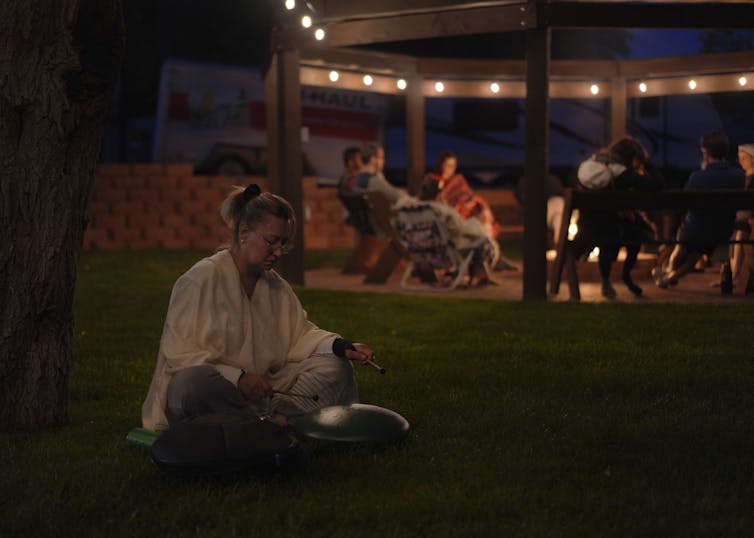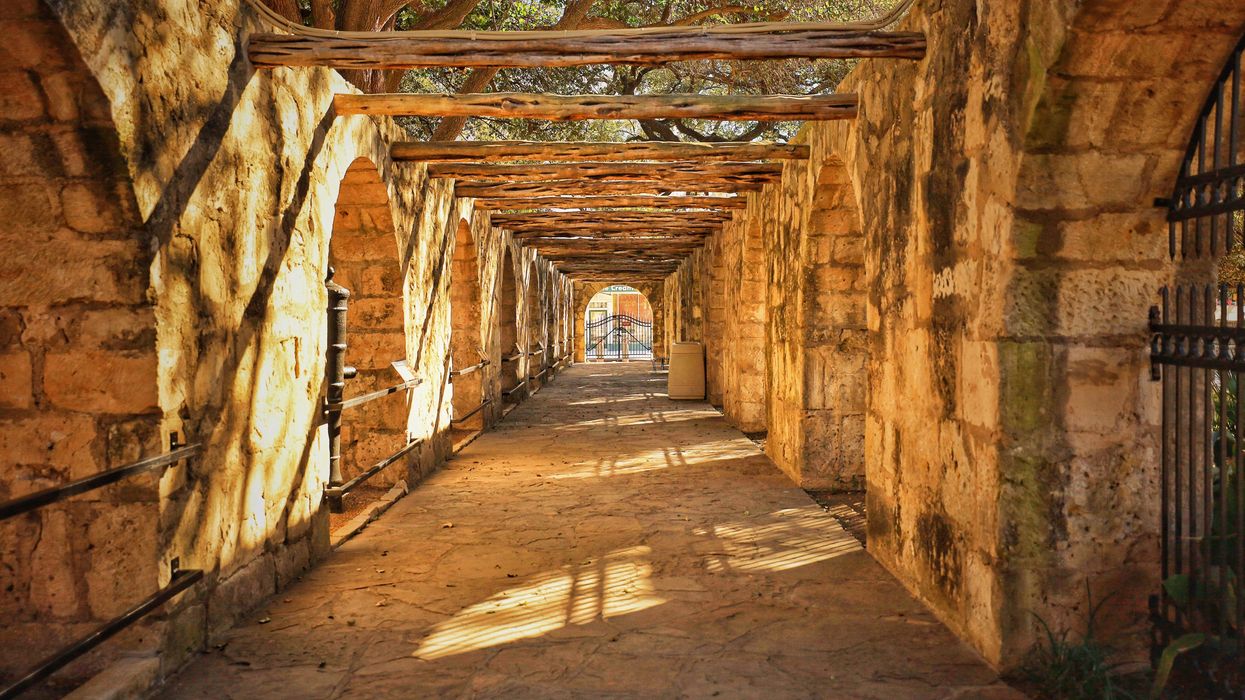INDIA
Globalisation of McCarthyite Witch-Hunts
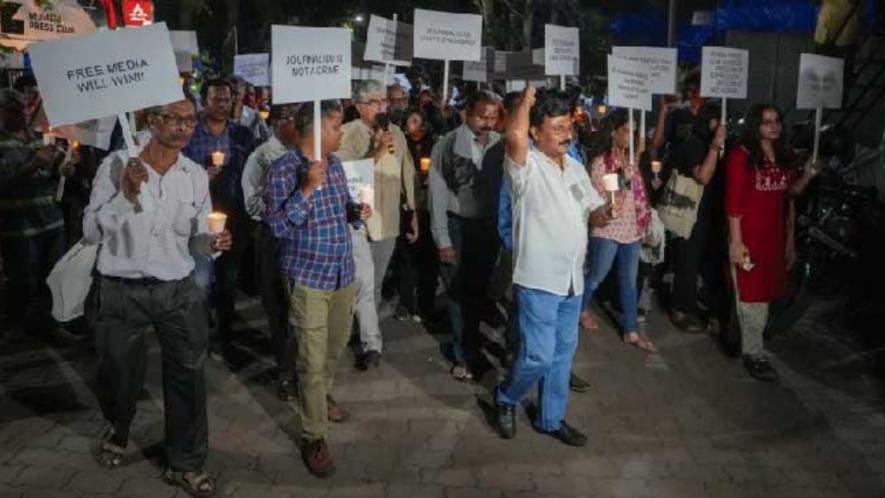
Journalists take part in a candle march against Police raid on news portal NewsClick, in Mumbai on Thursday. Image Courtesy: PTI
The Central government’s hounding of portal Newsclick reminds one of the children’s story about a tiger and a goat drinking water from the same stream. The tiger, wanting an excuse to attack the goat, accuses it of muddying the water it is drinking; when the goat points to the impossibility of this, as the tiger is upstream and the water is flowing not to the tiger but away from it, the tiger says: “well, your father had muddied the water I was drinking”.
The Narendra Modi government has been after Newsclick for months. The Delhi police had searched its founder Prabir Purkayastha’s office and residence for evidence of financial misdemeanour for weeks on end. Despite all its efforts it could not find evidence to bring any charges against Newsclick, not surprisingly since no such misdemeanour had been committed.
Now, it has invoked a completely fresh charge, the charge of terrorism, has harassed scores of Newsclick employees including service providers, and arrested Prabir Purkayastha and Amit Chakraborty under the Unlawful Activities Prevention Act (UAPA), which is so draconian that any relief for the arrested is extremely difficult, even when the charges are palpably ludicrous, as they are in the present case.
This change of track on the part of the Delhi police has not been the government’s own original idea. It has come to the government from an utterly malicious article published in the New York Times, which accused a wealthy businessman, who is a US citizen, named Neville Roy Singham, of being close to the propaganda machine of the Chinese government and of using large sums of money to disseminate Chinese propaganda through a multiplicity of outlets, among which Newsclick found a passing mention.
The NYT article is malicious, because it gives no evidence of the violation of any US law; but uses a series of suggestions and innuendos to build up a scenario of Chinese world-wide operations, allegedly mounted through persons like Singham, to push Chinese propaganda.
Singham had declared in an e-mail to the NYT: “I categorically deny and repudiate any suggestion that I am a member of, work for, take orders from, or follow instructions of any political party or government or their representatives. I am solely guided by my beliefs, which are my long-held personal views.”
The NYT article does not directly refute this claim; nor does it make any direct allegations of violation of any American laws by either Singham or any of the organisations allegedly funded by him. (See the informative article by Caitlin Johnstone in Monthly Review Online, August 12, 2023). But, it presents a set of incidental details, each without any pertinence on its own, none directly making any accusations of malfeasance against Singham or any of the organisations allegedly linked to him, but all adding up together to present an illusion of malevolence on a global sale orchestrated by the Chinese authorities.
If Singham has done nothing illegal, and even the NYT article does not directly say he has, the organisations he has supported in the US have not done anything illegal either; nor have they promoted any Chinese “propaganda” other than taking a generally anti-imperialist Marxist position. What is mischievous and dishonest about the NYT article is that it implicitly and through innuendos equates anti-imperialism with Chinese propaganda; and herein lies the scope for McCarthyite witch-hunts that it opens up.
Not surprisingly, Senator Marco Rubio in a letter to the US attorney general Merrick Garland has already demanded that American Leftist anti-war groups should be investigated because “they are tied to the Chinese Communist Party (CCP) and operating with impunity in the United States” (quoted in Johnstone).
Unlike the NYT article, which was constrained to making only innuendos, presumably under the instructions of NYT’s lawyers keen to avoid legal action against it, the Delhi Police has no such constraints; and it is armed with a law (the UAPA) under which it would not be called upon to defend whatever accusations it makes against individuals or organisations, for months if not years. So, it is emboldened on the strength of the same NYT article to make wild and baseless claims about Newsclick being used for promoting Chinese propaganda.
I say “baseless” because, as a regular reader of Newsclick, I have come across no instance of Newsclick publishing anything remotely linked to any specifically Chinese government position, other than what constitutes a general Left or Marxist perspective on international affairs. It has, of course, a general respect for the Chinese revolution; but every Third World anti-imperialist worth his or her salt must have such respect anyway.
This entire episode demonstrates two kinds of dialectics at work. The first is the dialectics between “liberal” and “fascistic” McCarthyism. The NYT is considered a “liberal” newspaper, even though it generally supports US imperialist wars all over the world; and a fundamental tenet of liberalism according to its proponents is the acceptance of diversity of views and opinions in society and of freedom to propagate such views within the confines of the accepted laws of the land.
For the NYT to publish an article that, no matter what constraints it imposes upon itself as a fig-leaf, clearly encourages McCarthyite witch-hunts of anti-imperialist, anti-war, Left-wing groups, and thereby strengthens fascistic elements in society, underscores the first kind of dialectics.
It is in conformity with the fact that the instruments used for repressing Left and democratic movements by the fascistic forces, when they enter government, are often forged by the liberal bourgeois elements that had preceded them. It is noteworthy in this context that the dreaded and thoroughly misused UAPA in India was first introduced by the liberal bourgeois government of Manmohan Singh, though, of course, the Modi government now uses it, after passing an amendment, against individuals and not just against organisations. This dialectics between liberal anti-communism and fascistic repression must not be lost sight of.
The second kind of dialectics is demonstrated by the fact that a “liberal” move toward a McCarthyite witch-hunt initiated in the US has its repercussions in India and is carried forward by a fascistic government here. This globalisation of McCarthyism is a phenomenon specific to the current era of globalisation.
The ‘Red Scare’ created by the fake Zinoviev Letter in 1924 in Britain, which had led to the defeat of Britain’s first labour government under Ramsay Macdonald, had been essentially a British phenomenon. Likewise, Senator McCarthy’s witch-hunt in the US in the 1950s, which left an indelible imprint on American society, was essentially an American phenomenon that did not have any substantial direct global repercussions. But, in the current era of globalisation, the impact of any such “manufactured” Red Scare does not remain confined to the country of its origin; it is used, often quite viciously, in other parts of the world.
The NYT may claim that its article did not make any direct, actionable accusations against Singham or the organisations to which he may have contributed, but in any Third World country, like India under the present Narendra Modi dispensation that has been freely applying a draconian law like the UAPA, such an article can be, and has been used, to dreadful effect against individuals with progressive world views, who have the courage to speak ‘truth to power’ and keep alive the democratic spirit.
The NYT cannot be oblivious of such an impact that its article will have in the contemporary era; the fact that it nonetheless went ahead and published such an article is a telling comment on contemporary Western liberalism.
Invoking the China bogey is the form that McCarthyism takes in the present era. And the Modi government, which insists that not an inch of Indian territory has been lost to China of late, seeks ironically to exploit the anti-China mood, generated by reports of actual loss of such territory, for a McCarthyite targeting of what remains of an independent media in the country.
If liberalism is to be genuinely anti-fascist, then it must shed its propensity to generate Red Scares, and, more generally, its McCarthyite predilections. This is especially necessary in the present era when McCarthyism has a tendency to get rapidly globalised, and when the world capitalist crisis has created a fertile ground for the growth of fascism everywhere in the world, fascism that can derive sustenance from such McCarthyite witch-hunts.
Punitive Action Against Newsclick Echoes Muzzling of Press in Punjab in 1919
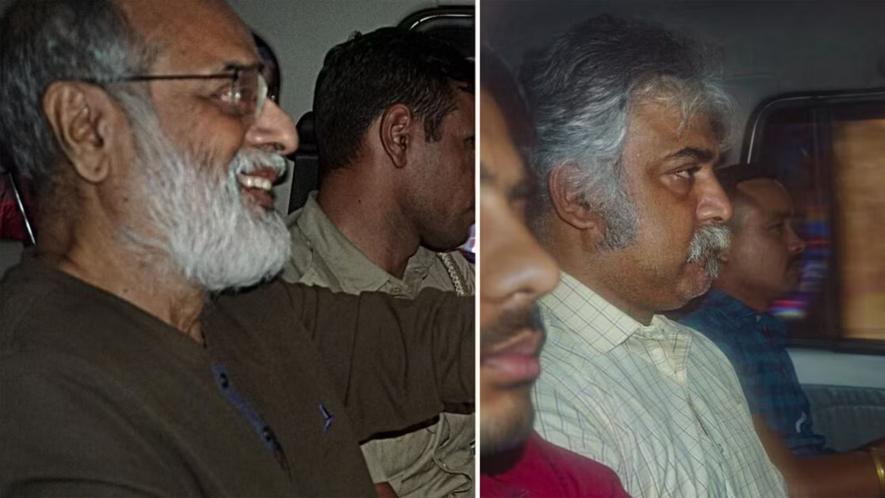
NewsClick founder Prabir Purkayastha (L) and HR Head Amit Chakravarty. Image Courtesy: PTI
The massive scale of police raids on the web portal, Newsclick, and those connected with it as contributors, employees and even ex-employees, has shocked the world. The sheer scale of such raids at the houses of close to 80 people, including about 50 journalists, across the country possibly constitutes the largest ever coercive action taken against any single media outlet in independent India.
The slapping of the draconian UAPA (Unlawful Activities (Prevention) Act) against Prabir Purkayastha, the founder editor of Newsclick, and Amit Chakraborty, the Human Resources head and their arrest and police remand for conducting investigation against them for an alleged “terror case with Chinese links”, amounts to equating independent journalism with terrorism.
The highly unacceptable case of sealing the office of the web portal for two days led to complete shutdown of its activities to transmit news and views, so essential for functioning of our democracy and holding the government to account.
Even earlier in 2021, the Enforcement Directorate (ED) had raided several of those associated with Newsclick, including Purkayastha for a week. No charge sheet has been filed on the matter and the Delhi High Court protected him and others from any coercive action.
Read Also: Statement by Newsclick on Oct 3 Raids by Special Cell of Delhi Police
Muzzling of Press in Punjab in 1919 Under Martial Law
All the intimidating and alarming measures, especially invoking terror charges under UAPA, chillingly remind one not of the days of the Emergency during 1975-1977 but of the British era Martial Law imposed on Punjab in 1919 when the Jallianwala Bagh massacre took place. During those frightening days, the magnitude of the muzzling of the press was such that the intensity of its scale would be comparable with the menacing measures taken against Newsclick.
Gandhi's Report
Consider the following excerpts from the “CONGRESS REPORT ON THE PUNJAB DISORDERS”, authored by Mahatma Gandhi in 1920 after the terrible Jallianwala Bagh massacre of 1919.
While flagging the point that there was suppression of public opinion by gagging the local press and shutting out nationalist newspapers from outside the Punjab, the report observed:
“Even a scholarly lawyer of Mr. Manohar Lal’s standing… was arrested at about 7.30 a.m. on the 18th of April, as a trustee of The Tribune newspaper. There was no warrant, nor was he told the charge on which he was arrested”.
Those words of 1919 resonate in the police action against Prabir Purkayastha and Amit Chakraborty, who were arrested without any warrant and were not even informed of the grounds on which they were being remanded to police custody (they are now in judicial custody). They were not even given access to the copy of the FIR (first information report) filed against them under UAPA. They succeeded in getting a copy only after moving the court, which ordered the authorities to disclose the contents of the FIR and provide a copy to them.
The close parallel between what happened to Newsclick in 2023 and the press in Punjab in 1919 under Martial Rule is striking. Again, it is imperative to reproduce some more excerpts from the aforementioned Congress report.
“Mr. Kalinath Roy, the able Editor of The Tribune, …was duly arrested, tried and convicted for seditious writings. We have no hesitation in saying that there was not a word of sedition in Mr. Roy’s writings. His trial was nothing less than an outrage on decency in political life. No less cruel was the prosecution of the Editor of Pratap, a paper that had just commenced its career and whose Editor was widely known for his meekness and the harmless religious character of his writings. The existence of independent journalism became an impossibility during the Martial Law regime and The Tribune, the Punjabee, and the Pratap stopped publishing”.
Replay of Repression on Press in Punjab
The repression unleashed on the press in 1919 in Punjab and the arrest and prosecution of the editors of the several newspapers get reflected in the harsh and menacing action taken by the police against Newsclick. Gandhi’s observations that “The existence of independent journalism became an impossibility during the Martial Law regime” sounds so contemporary in India of 2023, when Newsclick and several other media units are being subjected to highly punitive police measures crippling its independent functioning.
Earlier, too, newspapers like Dainik Bhaskar, news outlets like The Wire, Newslaundry, Caravan and others have faced coercive police action, even as they remained engaged in performing their roles in accordance with the norms and values so central the ethos of independent journalism. It is rather tragic that such severe and harsh measures are being taken when there is neither declaration of an Emergency nor Martial Law, while the ruling leaders of India set the narrative that India is the ‘mother of democracy’.
Gandhi's Prescient Observations
A few days after drafting that Congress report, Mahatma Gandhi delivered a speech at Bezwada on August 23, 1920. What he said about the British Government in India is applicable to the ruling regime of country which is now controlling the State apparatus. "It is a Government," Gandhi said, "...does not scruple to use means fair or foul in order to gain its ends". When those were uttered by him the general public gathered to listen to him shouted "Shame, Shame." Observing that "No craft is above that Government," Gandhi sharply remarked, "It resorts to frightfulness, terrorism. It resorts to bribery in the shape of titles, honours and high offices". Once again, people responded by crying “Shame!” "In any sense," he claimed, "it is autocracy doubly distilled, appearing in the guise of democracy..."
He then added, "... the greatest gifts of a crafty, cunning man are worthless so long as cunning resides in his heart". Gandhi proceeded to say that he outlined those attributes of the British government not to excite people's angry passions but to enable them to appreciate fully the forces that were matched against them. "Anger will serve no purpose," he said. "We shall" he asserted "have to meet their untruth by truth,"…"terrorism, their frightfulness by bravery..."
Gandhi very forcefully stated that unbending bravery was demanded from every man, woman and child to defeat the British regime sustained in India by unapologetically employing, what he called, the doctrine of frightfulness manifested in Punjab in the form Dyerism (General Dyer) which, among others, muzzled press through coercive action.
Unbending Bravery by Newsclick
It is tragic that there is a replay of that doctrine of frightfulness and the challenges arising out of it are getting manifested in the application of the draconian terror law, and the remedy sought by Prabir and Amit, by moving the judiciary, represents what Gandhi said "unbending bravery" to meet their untruth by truth." Satya Meva Jayate.
S N Sahu served as Officer on Special Duty to President of India K R Narayanan. The views are personal.
Voices Raised in Favour of NewsClick on a Large Scale in Punjab

Farmers, labourers, students, human rights and cultural organisations of Punjab have raised their voices against the FIR lodged by Delhi Police against NewsClick and numerous journalists associated with it, calling it an attack on democracy and freedom of expression. There have also been demonstrations against the Narendra Modi government and Delhi Police at many places in Punjab.
The Samyukt Kisan Morcha and other farmer organisations say that media houses like NewsClick, which covered the farmer movement, the protests and other issues arising out of the Citizenship Amendment Act and the National Register of Citizens impartially, are facing false allegations. Because their journalism questioned those who wield power and authority, they are being defamed and harassed, according to Joginder Singh Ugrahan, president of the Bharatiya Kisan Union (Ekta-Ugrahan), Punjab’s largest farmer organisation.
Ugrahan says, “The action taken against the journalists and staff associated with NewsClick is the latest anti-people step of the Modi government. By taking action against NewsClick, the government is targeting journalists who impartially covered the farmers’ struggle by associating it with China and presenting it as if some foreign power is behind the farmer’s struggle. This is a policy of suppressing people’s voices and struggles under the guise of chauvinism. All democratic people, including farmers, should raise their voice against this.”
The Kirti Kisan Union, another influential farmer organisation of Punjab, held demonstrations across Punjab against the SYL [Satluj-Yamuna Link] canal issue and the raids on NewsClick. In it, apart from farmers, ordinary people also participated enthusiastically. Rajinder Singh Deep Singhwala, general secretary of Kirti Kisan Union, says, “In Hitler’s time, as soldiers were arresting a poet, his child asked, ‘Mother, why are they taking Papa away?’ The mother replied that your father had written a poem against the ruler. The child said, ‘What is the big deal in it? The ruler could have written a poem against Papa; why arrest him?’ The mother replied, ‘Son, the ruler is not a poet; he is a fascist--he could only have done this.’
“It is the same thing in the NewsClick case. If the Modi government had any problem with NewsClick’s work, it could have countered through its ‘Godi Media’. But the Modi government does not believe in freedom of communication and expression. Therefore, this is what the government could do. We demand that the cases registered under the UAPA [Unlawful Activities (Prevention) Act] against media houses and journalists be cancelled. A story has been fabricated in the FIR to defame the farmer’s historical movement. This is part of the long-standing policy of suppressing anti-government voices.”
In Punjab, youths, students and other sections protested against this action. Youth and student organisations like the Naujawan Bharat Sabha (Lalkar), Students for Society, Punjab Students Union, Punjab Students Union (Shaheed Randhawa), Punjab Students Union (Lalkar), Naujawan Bharat Sabha etc. demonstrated in different parts of the state. Voices were raised in favour of NewsClick in all the prominent universities of Punjab. Impressive demonstrations were held in districts like Bathinda, Fazilka, Faridkot, Chandigarh, Patiala, Amritsar, Moga, Barnala, Muktsar, Sangrur etc., in which young people participated enthusiastically.
Sandeep, president of Students for Society, says, “These attacks are part of the Modi government’s policy to suppress democratic voices. Now, things have reached their peak. Writers, social workers and journalists who question the Modi government are sometimes raided by the police and sometimes by other agencies. They are being continuously harassed. This government is creating narratives like Maoism, left-terrorism and China to win the 2024 elections.” Amandeep Singh, general secretary of the Punjab Students Union (Lalkar), termed the action taken against NewsClick and journalists as repressive and sees it as an attack by the Modi government on freedom of speech.
The cultural and literary organisations of Punjab have also strongly condemned the arrest of journalists and the attack on journalism. Two big organisations of Punjabi writers, ‘Kendriya Punjabi Lekhak Sabha’ and ‘Pragatisheel Lekhak Sangh, Punjab’, have also expressed their anger over this. Expressing his feelings, Dr Sukhdev Singh Sirsa, General Secretary of the Kendriya Punjabi Lekhak Sabha, says, “It is clear that the Modi government is under a lot of pressure and scared. It cannot tolerate any voice raised against it. That is why honest and fearless journalists, intellectuals and workers are being harassed. I wish our writers, too, would not limit themselves to mere condemnatory statements but give up their fears, petty greed and desires and stand with media organisations like NewsClick and journalists, intellectuals and social workers who question power. There should be protests on a large scale.”
The ‘Jan Sangharsh Manch Haryana’ in Punjab’s neighbouring state also organised an impressive protest demonstration in the Kurukshetra district in favour of NewsClick and journalists. Phool Singh, President of the Jan Sangharsh Manch Haryana, said, “This is a dictatorial step taken by the Modi government to threaten independent media institutions and impartial journalists and stop them from doing their work. Let people raise their voices against the Modi government to protect media freedom and freedom of speech.”
The author is an independent journalist. The views are personal.
Journalist Bodies Flay Ongoing Harassment of Newsclick Staff, Appeal for Support
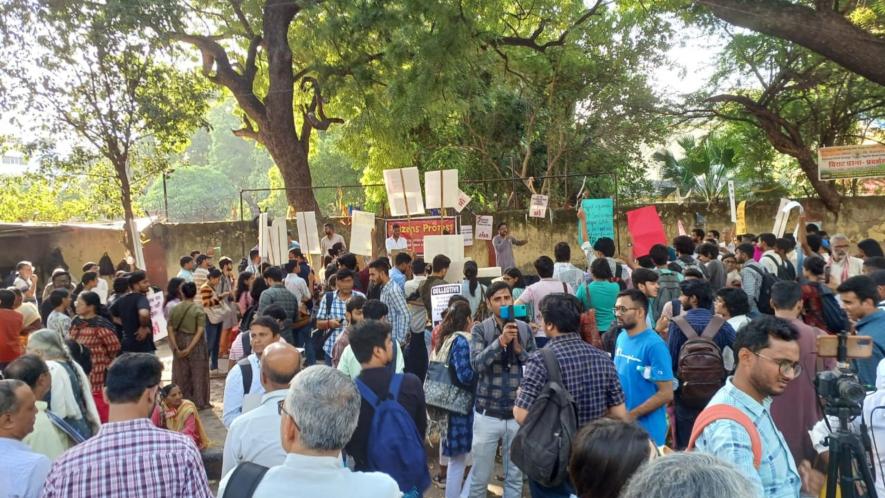
New Delhi: Journalists organisations have expressed outrage at portal Newsclick’s continued harassment by government agencies. On Wednesday, a fifth probe agency, the CBI, again searched the premises of the portal’s office and its Editor-in Chief Prabir Purkayastha’s residence.
A fresh FIR was filed by CBI on October 11, after which another search was carried out, close on the heels of massive raids and seizure of electronic devices of close to 80 persons, including 50 scribes, on October 3, under the draconian anti-terror law, UAPA or Unlawful activities Prevention Act. The portal’s Editor-in Chief Prabir Purkayastha and Human Resources head Amit Chakravarty were arrested and devices of several veteran contributors and freelancers were seized, ending their work with a jolt.
On Wednesday, six media organisations – Press Club of India, Indian Women’s Press Corps, Press Association, Digipub, Delhi Union of Journalists and Working News Cameramen's Association, issued an appeal for spare laptops and phones for the affected journalists so that their livelihoods are not hit.
‘All procedure was flouted as seizure memos were not issued for every equipment seized. Employees have had to purchase new phones and organize laptops in order to continue functioning. As of now, their right to work and livelihood stands affected indefinitely. Many Newsclick employees are single earners with elderly family members to support.”
Recall that Newsclick has, since 2021, already been probed by the ED, EoW (Delhi Police), IT department, Delhi Police Special Cell, the last raid just a week ago. The portal said it had provided all documents devices to all the probe agencies, “yet the Government that has not been able to substantiate any charges against Newsclick despite being in possession of all its information, documentation and communications, needed a motivated and bogus article published in the New York Times to invoke the draconian UAPA and attempt to shut down and stifle independent and fearless voices that portray the story of the real India – of peasants, of labourers, of farmers, and other oft-ignored sections of society.”
Read the full statement below:
Joint statement:
Journalist bodies condemn the continued harassment of Newsclick employees: issue appeal for support
Press Release
October 11, 2023
We the undersigned journalist organizations and associations express our deep outrage at the sustained and relentless harassment of the employees of Newsclick. The office of Newsclick and the home of the founder-editor were raided by the CBI today.
During the raids on October 3 at the homes of Newsclick employees, laptops and phones were seized indiscriminately, including those of elderly and sickly family members of the employees. All procedure was flouted as seizure memos were not issued for every equipment seized. Employees have had to purchase new phones and organize laptops in order to continue functioning. As of now, their right to work and livelihood stands affected indefinitely. Many Newsclick employees are single earners with elderly family members to support.
As there is no assurance of the return of their equipment, we appeal to members of our fraternity and the public at large to help out in whichever form possible, e.g, spare laptops or phones in order that they are able to continue to work and sustain themselves.
Sd/-
Press Club of India, Indian Women’s Press Corps, Press Association, Digipub, Delhi Union of Journalists and Working News Camermen's Association
Delhi: Left Parties Protest Police Action Against Journalists, Newsclick Staff
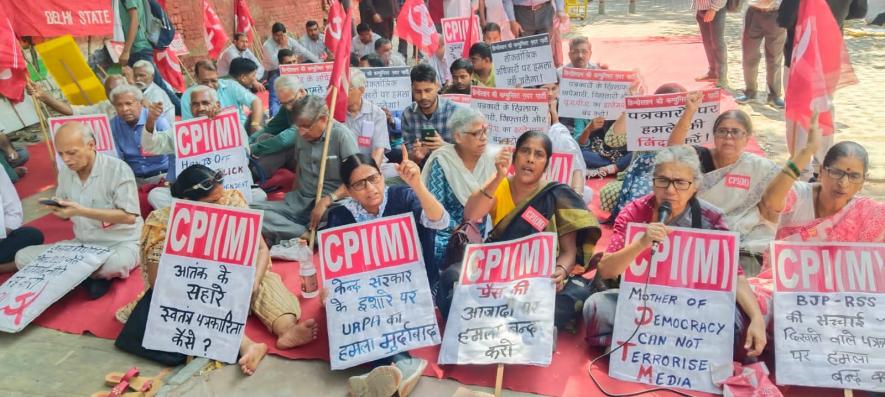
Social activists and people in the political sphere associated with various Left parties and trade unions gathered at Delhi's Jantar Mantar, demanding the release of NewsClick's editor-in-chief Prabir Purkayastha and HR head Amit Chakravarty. Not only them, but the crowd demanded the repeal of UAPA and severe attack by the current regime on the free press.
Representatives from CPI, CPI(M), CPI(ML), CITU, AICCTU, and AIFB, among other organisations, were present to register their protest.
On October 3, 2023, over 70 houses of journalists, contributors and consultants associated with NewsClick were raided, and their phones and laptops were seized by the Special Cell of Delhi Police. The list of the people raided included even the independent journalists who had in the past written for NewsClick and ex-employees who currently have no connection with the organisation.
On the same day, even the NewsClick office was temporarily sealed, and the journalists were called for questioning at the Delhi Police Special Cell office. Several journalists were even called for a second round of questioning on October 5, 2023, while their devices remained with the police. The questioning continued on October 6.
Furthermore, Purkayastha and Chakravarty were arrested and sent on remand for seven days. The matter concerning their remand custody has been heard in the Delhi High Court, and the judgment stands reserved as of now.
"If these people can stoop so low, we must get on the streets. Delhi Police chargesheet looks like it's a movie script," said KM Tiwari, the General Secretary of CPI(M), Delhi.
He further added, "In a condition like this, all opposition parties must come together and pass a strong message. They even sealed NewsClick; this is why we must take to the streets and show them our power and unity."
People came out with placards that said "Stop the Attack on Freedom of Press", "Release the seized devices of journalists", "Hands off NewsClick", "Release Prabir and Amit", and many other such slogans.
Amid sloganeering, leaders from the different parties were addressing the crowd.
CPI(M) polit bureau member Brinda Karat lashed out at the RSS-BJP-led government at the Centre for taking the illegal UAPA route to circumvent the HC protection to these journalists after the ED-CBI-IB conspiracy to frame them fell flat without any proof. She added that the nationwide spontaneous protests against their arrests also pricked the governmental propaganda packed with lies against Newsclick.
Talking about the long fight that one needs to register in current circumstances, All India Secretary of CPI Amarjeet Kaur said, "We'll talk about the journalists and revolt against the draconian UAPA, that's true. But we need to understand that for their release, we are fighting a fascist regime. The attack is on everyone who talks and dares to take a stand against the government. When Prabir and other reporters were taken, they were asked if they had covered the farmers' protest, CAA, and other protests. How is this anti-national? If a journalist does not cover such issues, then the journalist is failing. The truth is that this government is trying rigorously to suppress the common public and the voices that dare to amplify the causes of the farmers and workers."
The communist parties had even organised public gatherings in over 25 places in Delhi, involving the general public and explaining what has been happening to the digital media. Representatives said that more such marches and events would be planned across India in the near future.
The AIFB National General Secretary G Devarajan, adding to what Amarjeet Kaur mentioned, said, "This will not be limited to NewsClick or any one political party. It's a statement that the government has given to the whole press and any political party. It was a clear statement from the government that the race for 2024 elections has begun, and they will not stop here."
SK Pande, President of the National Alliance of Journalists and Vice-president of the Delhi Union of Journalists, also attended the protest to express his gratitude to the political parties who had taken a firm stand for the journalists today facing attacks from the current regime. He also said that the citizens now need to come together and take this movement forward to prevent such attacks from happening again.
Many women from different organisations were also present in solidarity with the journalists. Among them were research scholars and activists who have been observant of the attack on the press.
Sweta, a student from DU, expressed how she feels about the country's situation as a whole.
"It has been a very challenging phase for all of us. As a young student, I feel scared to write anything on social media, and I think this is the purpose behind the actions taken."
The demonstration which saw the participation of hundreds of people from all walks of life demanded in one voice the immediate release of those journalists arrested under UAPA and an end to the RSS-BJP attacks against free media.



